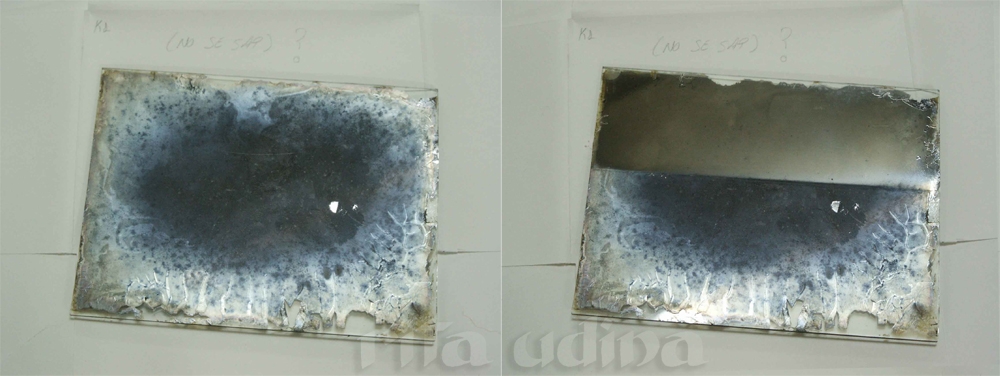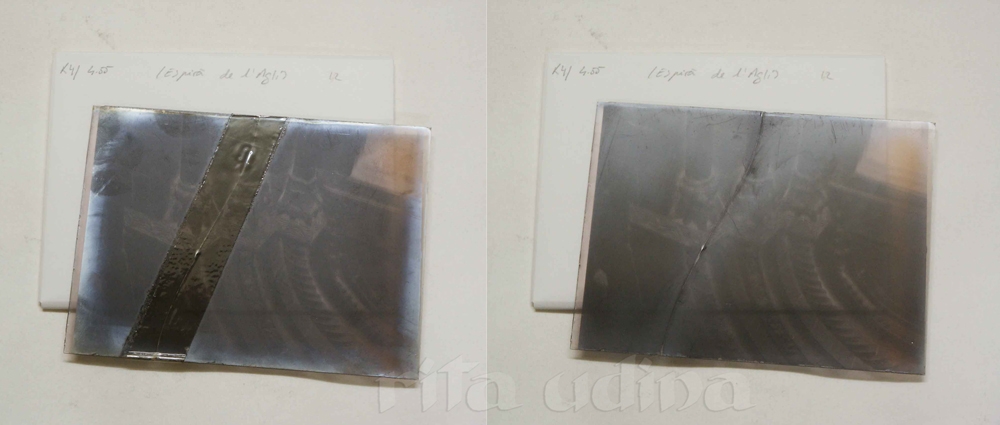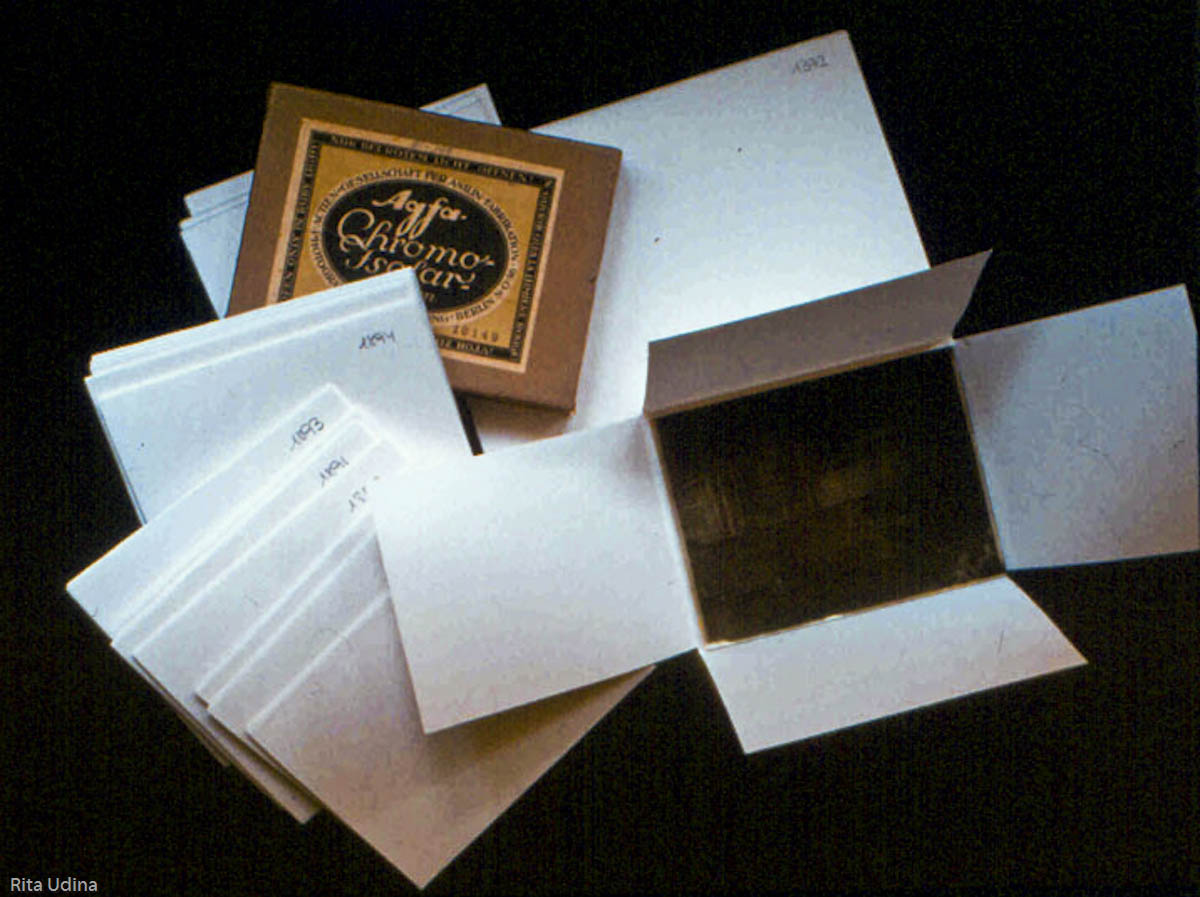Glass plate conservation (I)
“Glass plates” are silver gelatine photographs on a glass support. That is, the support is a glass and the image is formed on a silver gelatine emulsion which contains silver salts.
A very tipical damage is dicroic (also lnown as silver mirroring). SIlver mirroring is a surfacing emergence of metallic silver (Agº) expelled by the emulsion. When it is very much intens it hinders from seeing the image normally, and whe see the negative image instead, reflected by the metallic silver.
Acidity and moisture enhance this decay, that’s why the edges are likely to be more affected since they are more exposed to air and pollutants and acidity. Original board boxes are most of the times made with acidic boards.
Below some glass plates from Domènech i Montaner fund from Association of Architects (COAC) historical archive. Lluís Domènech i Montaner is one of the paradigmatic figures of catalan modernism (liberty style) in architecture. His passion for architecture pushed him walking all over Catalonia equipped with camera and glass plates in order to photograph romanseque architecture. can you imagine? Climbing uphill on a donkey with camera and glass plates?

Glass plate from the Association of Architects of Catalonia (CoAC) – Historical Archive, with severe silver mirroring. Left, before treatment, right during silver mirroring removal.

Glass plate from the Association of Architects of Catalonia (CoAC) – Historical Archive, with mild silver mirroring along the edges and fingerprints. Tha glass was broken and a regular pressure sensitive tape gathered the fragments together. Right, after silver mirroring and tape removal.
Once treated it is recommended to store them in four flap envelopes, either made from buffered paper or neutral. Preferably the flap shall cover the whole surface, to avoid uneveness along ageing and abrasions. Furthermore, these four flap envelopes used in glass negatives provide a cushioning effect that diminishes the risk of breakage in case of vibration or careless handling. En each side of the plate there are four layers of paper, doing kind of an accordion. When storing plates together, each of them has five layers next to it ( four plus that one of the neighbouring one), except for the first and last plates, that have the board.
Still another advantge: it allows to write the reference of the image inside the ebnvelope, avoiding unnecessary handling and more invasive writing.

Original cardboard box with acidic decay (yellow), and new four flap envelopes to store plates. Historical fund of Gas Natural.
A supoer useful guide to identify and preserve these type of phtographs, and many other, is “Identificación y conservación de fotografías“ by Jordi Mestre i Vergés. I recommend it!
Filter post by:
Glass plate conservation (I)
“Glass plates” are silver gelatine photographs on a glass support. That is, the support is a glass and the image is formed on a silver gelatine emulsion which contains silver salts.
A very tipical damage is dicroic (also lnown as silver mirroring). SIlver mirroring is a surfacing emergence of metallic silver (Agº) expelled by the emulsion. When it is very much intens it hinders from seeing the image normally, and whe see the negative image instead, reflected by the metallic silver.
Acidity and moisture enhance this decay, that’s why the edges are likely to be more affected since they are more exposed to air and pollutants and acidity. Original board boxes are most of the times made with acidic boards.
Below some glass plates from Domènech i Montaner fund from Association of Architects (COAC) historical archive. Lluís Domènech i Montaner is one of the paradigmatic figures of catalan modernism (liberty style) in architecture. His passion for architecture pushed him walking all over Catalonia equipped with camera and glass plates in order to photograph romanseque architecture. can you imagine? Climbing uphill on a donkey with camera and glass plates?

Glass plate from the Association of Architects of Catalonia (CoAC) – Historical Archive, with severe silver mirroring. Left, before treatment, right during silver mirroring removal.

Glass plate from the Association of Architects of Catalonia (CoAC) – Historical Archive, with mild silver mirroring along the edges and fingerprints. Tha glass was broken and a regular pressure sensitive tape gathered the fragments together. Right, after silver mirroring and tape removal.
Once treated it is recommended to store them in four flap envelopes, either made from buffered paper or neutral. Preferably the flap shall cover the whole surface, to avoid uneveness along ageing and abrasions. Furthermore, these four flap envelopes used in glass negatives provide a cushioning effect that diminishes the risk of breakage in case of vibration or careless handling. En each side of the plate there are four layers of paper, doing kind of an accordion. When storing plates together, each of them has five layers next to it ( four plus that one of the neighbouring one), except for the first and last plates, that have the board.
Still another advantge: it allows to write the reference of the image inside the ebnvelope, avoiding unnecessary handling and more invasive writing.

Original cardboard box with acidic decay (yellow), and new four flap envelopes to store plates. Historical fund of Gas Natural.
A supoer useful guide to identify and preserve these type of phtographs, and many other, is “Identificación y conservación de fotografías“ by Jordi Mestre i Vergés. I recommend it!

